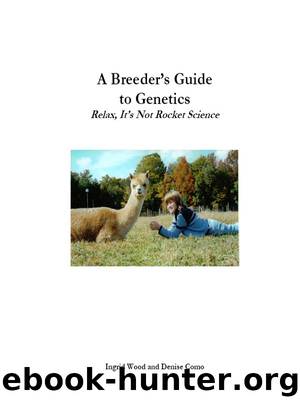A Breeder’s Guide to Genetics by Ingrid Wood & Denise Como

Author:Ingrid Wood & Denise Como
Language: eng
Format: epub
Tags: ebook, book
Publisher: Dogwise
Published: 2011-12-11T00:00:00+00:00
CHAPTER TWENTY-FIVE
Breeding for Extremes
CHAPTER TWENTY-FIVE
Breeding for Extremes
“Why are people never content with what they have? What is the purpose
of changing thesize of sheep? If they want a big sheep breed, why
don’t they go out and buy Suffolks?”
Carol Winchell (sheep breeder)
Why not, indeed? I swear there is a little Dr. Frankenstein hidden in all breeders. We just can’t seem to leave well enough alone. There exists an almost bizarre compulsion to tinker with the functional traits of animals to fit our perceived needs and expectations.
Geneticists and other sensible souls continually warn against selecting for extremes. Many breeders don’t listen, quite unaware of the damage they cause until it is too late. As a society, we admire and reward superlatives. The tallest building, the longest leap, the largest pumpkin – even the largest weed received a prize at the Ag Progress Days sponsored by Penn State University (in two categories, no less: broadleaf and grass).
Novice owners of large dogs are often inordinately proud of owning and exhibiting the biggest specimen among their competitors. It doesn’t matter that their Great Dane, Scottish Deerhound, Irish Wolfhound, or Borzoi is slabsided and much too straight in front and rear angulation. Size is what counts in their book! Some go in the other direction and strive for the record of breeding the tiniest toy dog in the country. So what if all its teeth fall out by the time it’s two years old and the patellas (knees) are unstable – its record will stand for quite some time. If the dachshund has a long back, then let’s give it an even longer back, no matter that the unfortunate dog will need expensive back surgery before it is three years old! (Although disc disease is common in dachshunds, I must state here that some researchers dispute the validity of the claim that extremely long backs cause problems.)
I read that domestic turkeys are bred for such an abundance of breast meat that it is physically impossible for the toms (males) to naturally breed the hens (pictures of certain weightlifters come to mind, and … oh, never mind). Only artificial insemination (A.I.) keeps the domestic birds alive and reproducing. Some dog breeds cannot whelp (give birth) without the assistance of the very humans who have caused the problems by selecting for extreme conformation that makes natural births impossible.
An alpaca breeder once proudly stated that the average size and weight of his animals had increased by 25 percent since he started his breeding program. Breeders familiar with spider leg syndrome in sheep may very well shudder upon hearing such a boast.
Several years ago, show judges started to award blue ribbons to the exhibitors of larger and longer-legged Suffolk sheep. Breeders began to select for these traits in their stock. Eventually, a genetic defect aptly named “spider leg syndrome” ( chondrodysplasia ) surfaced in those flocks.
The Merck Veterinary Manual (1998) describes spider leg syndrome lambs as having “pronounced medial deviation of the carpus and hock and are unable to stand without distress.
Download
This site does not store any files on its server. We only index and link to content provided by other sites. Please contact the content providers to delete copyright contents if any and email us, we'll remove relevant links or contents immediately.
| Fossils | Game Theory |
| Genetics | Molecular Biology |
| Organic | Paleontology |
Sapiens: A Brief History of Humankind by Yuval Noah Harari(13053)
Sapiens by Yuval Noah Harari(4537)
Homo Deus: A Brief History of Tomorrow by Yuval Noah Harari(4279)
Pale Blue Dot by Carl Sagan(4001)
Origin Story: A Big History of Everything by David Christian(3139)
Livewired by David Eagleman(3122)
Brief Answers to the Big Questions by Stephen Hawking(2878)
Inferior by Angela Saini(2831)
Origin Story by David Christian(2683)
The Evolution of Beauty by Richard O. Prum(2553)
Signature in the Cell: DNA and the Evidence for Intelligent Design by Stephen C. Meyer(2501)
The Gene: An Intimate History by Siddhartha Mukherjee(2491)
Aliens by Jim Al-Khalili(2382)
How The Mind Works by Steven Pinker(2213)
Sex at Dawn: The Prehistoric Origins of Modern Sexuality by Ryan Christopher(2150)
From Bacteria to Bach and Back by Daniel C. Dennett(2148)
A Short History of Nearly Everything by Bryson Bill(2135)
Endless Forms Most Beautiful by Sean B. Carroll(2083)
Who We Are and How We Got Here by David Reich(2059)
